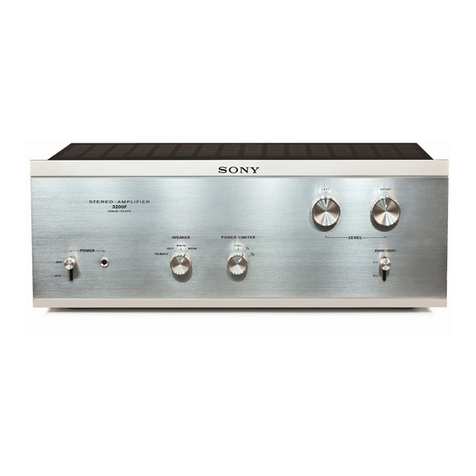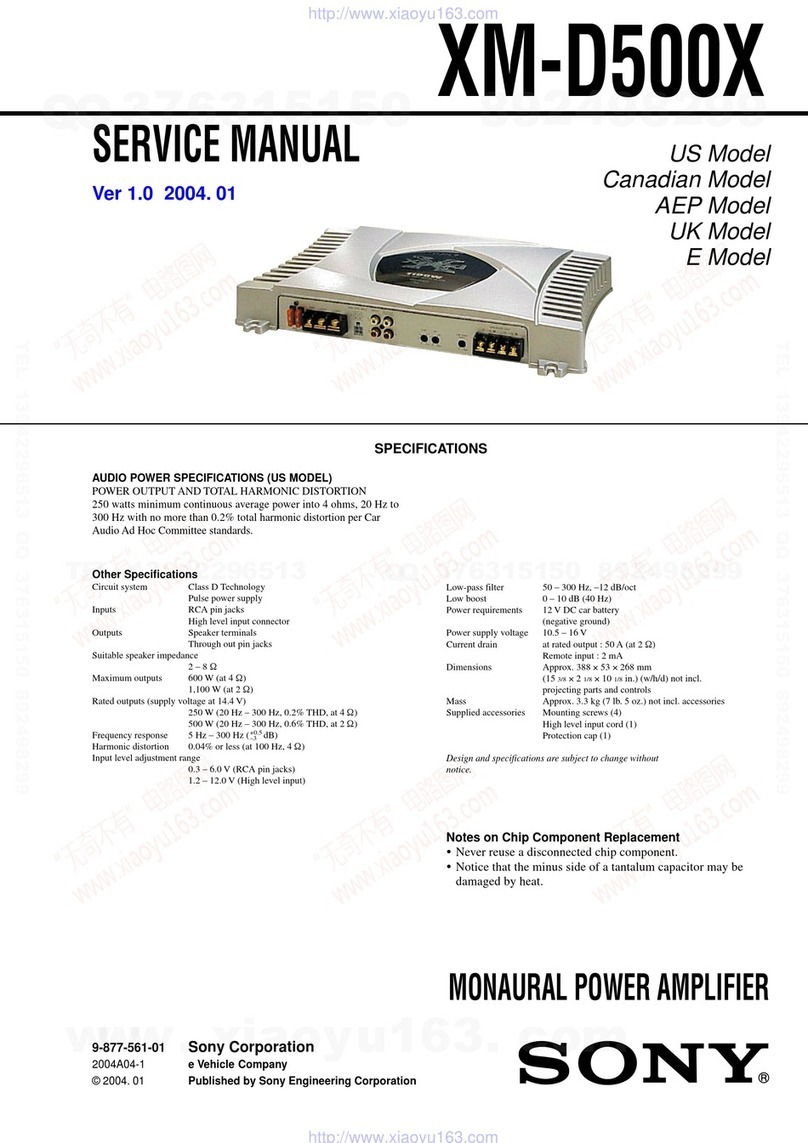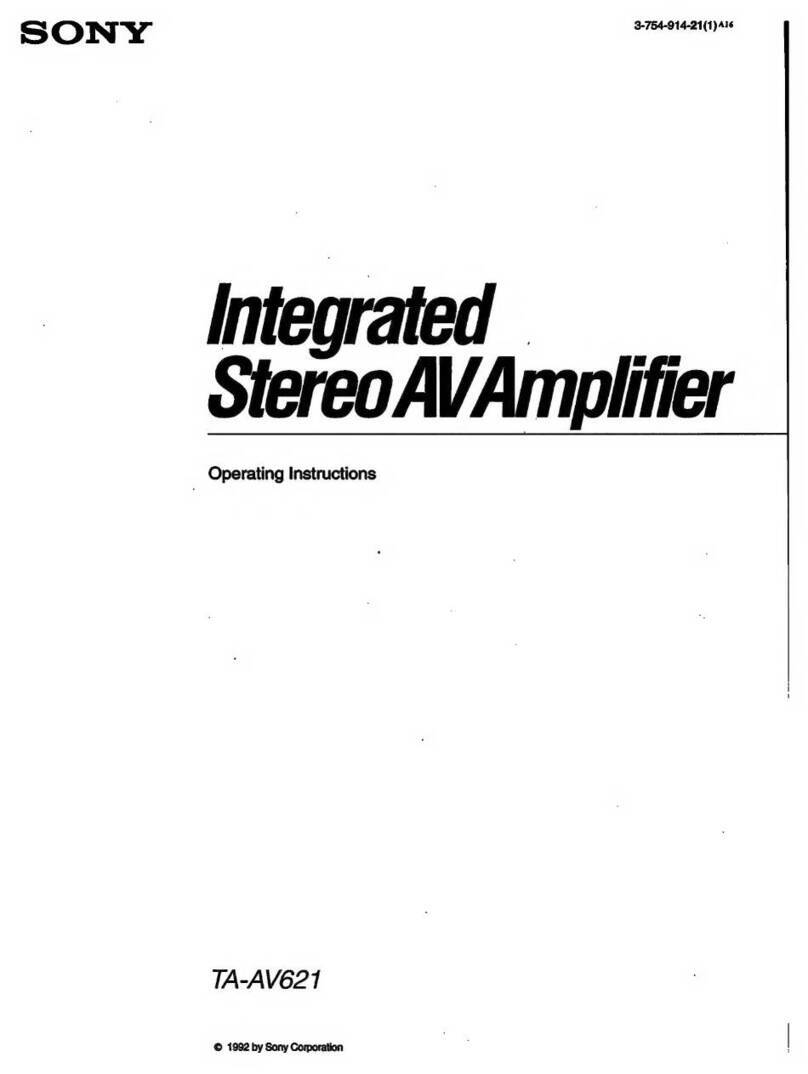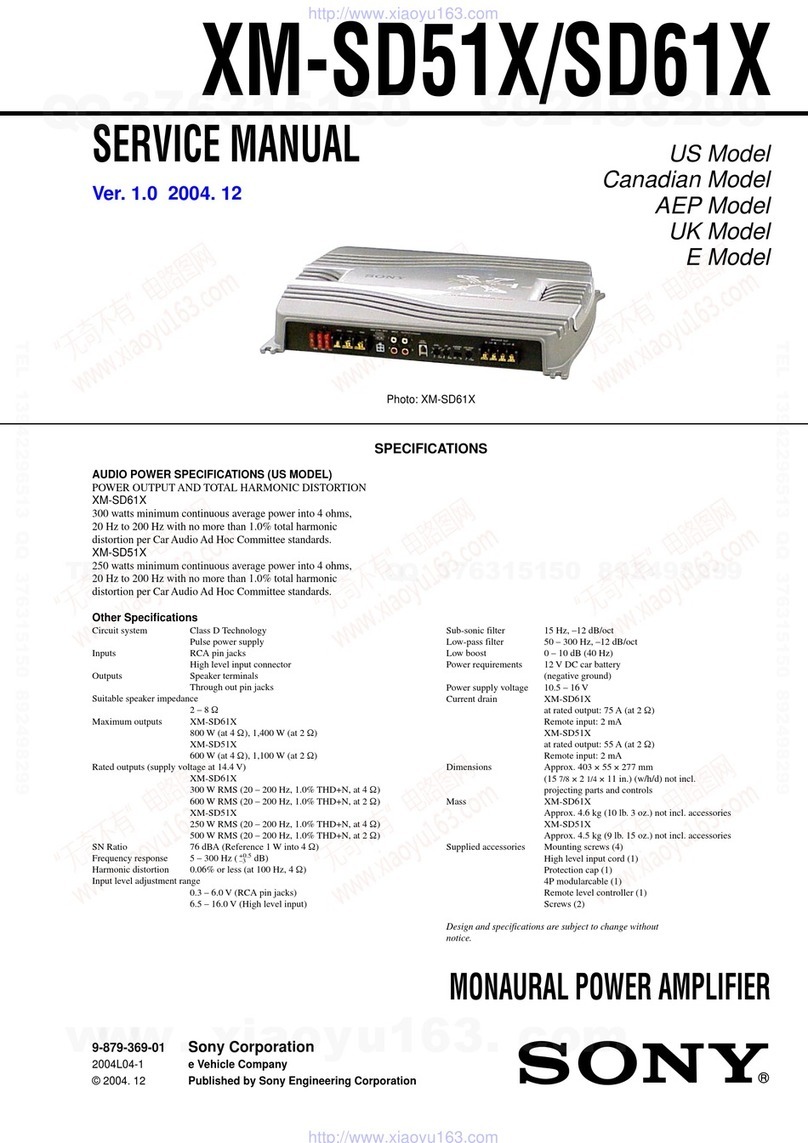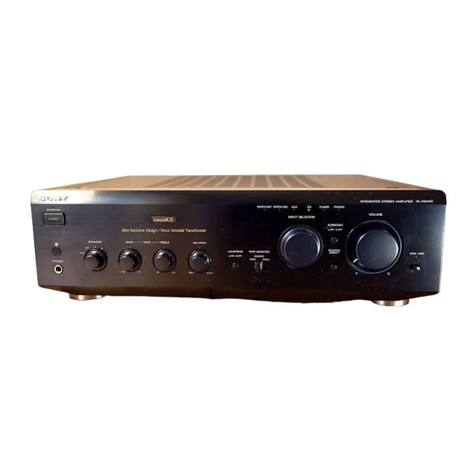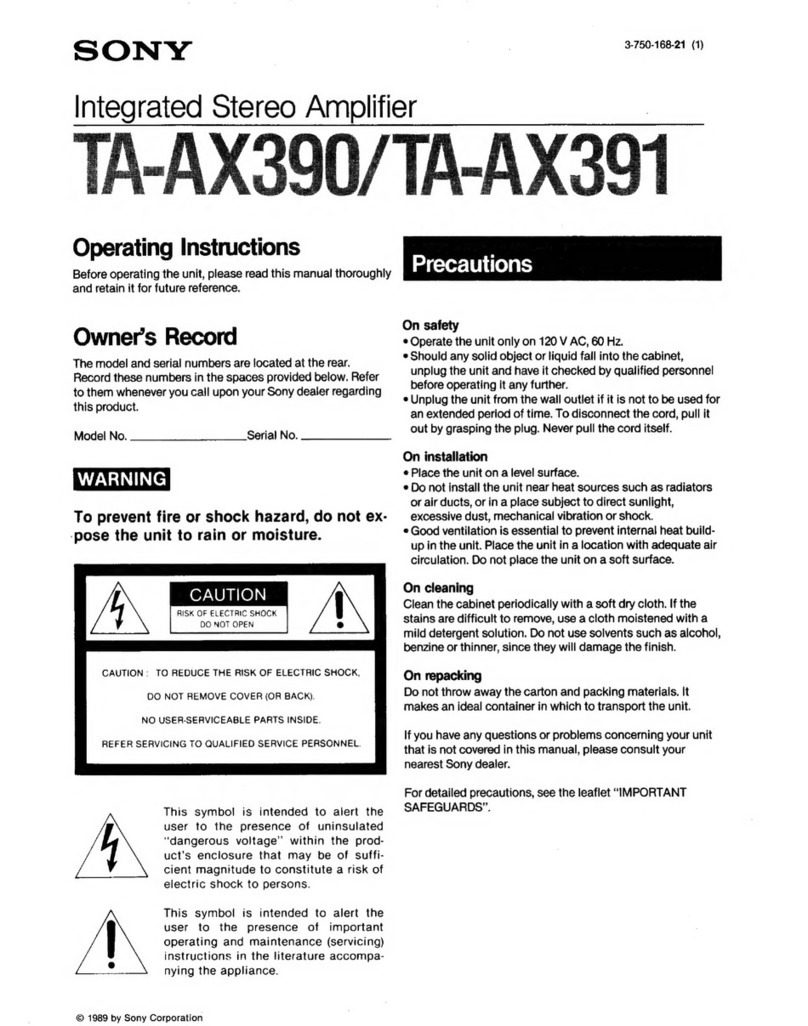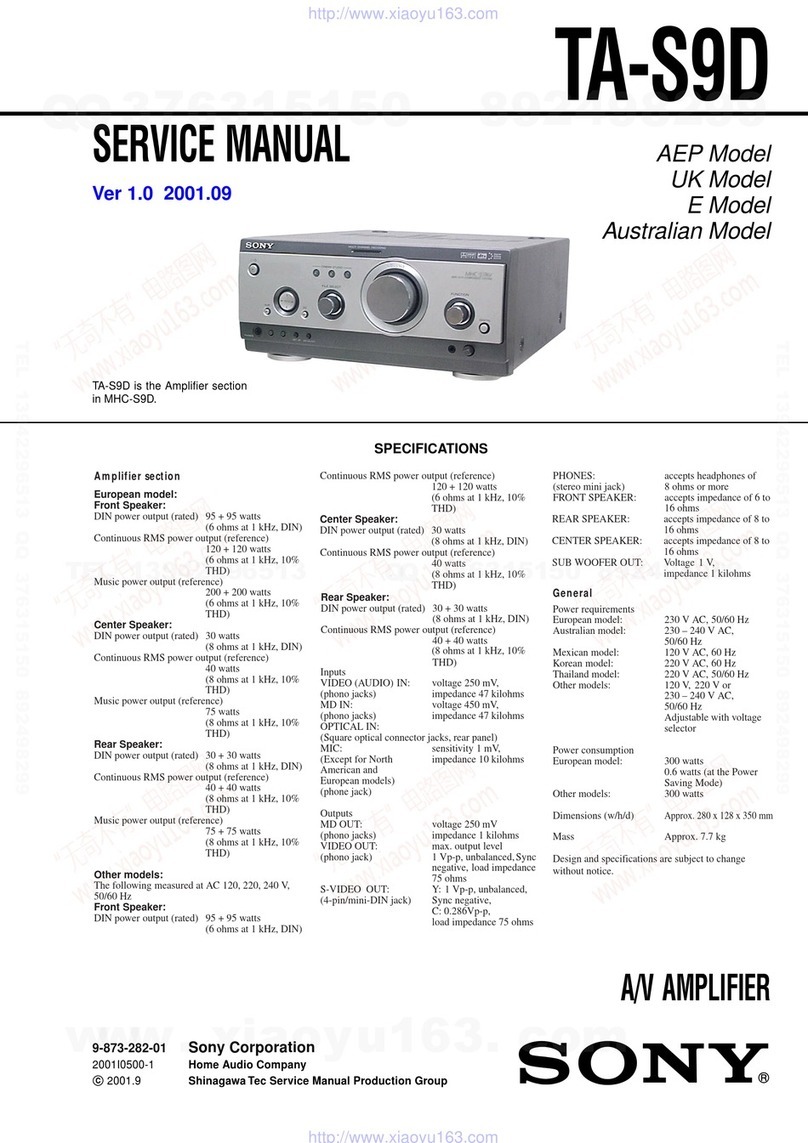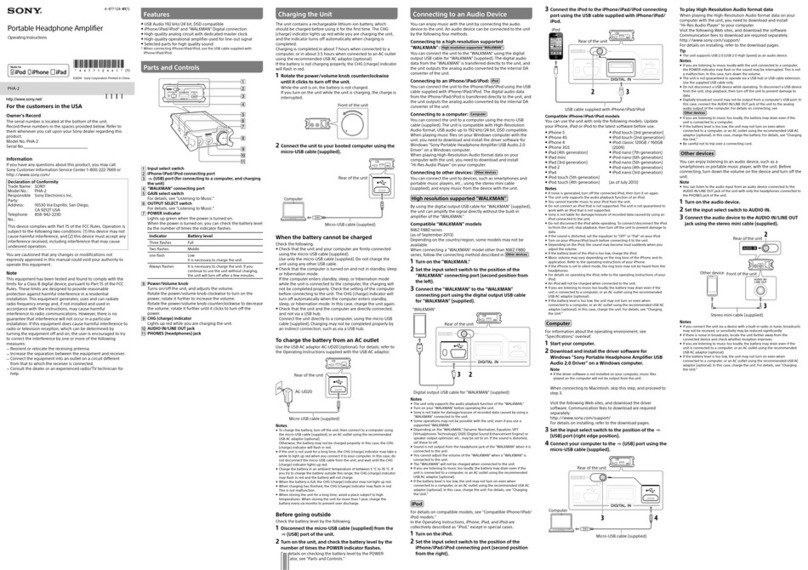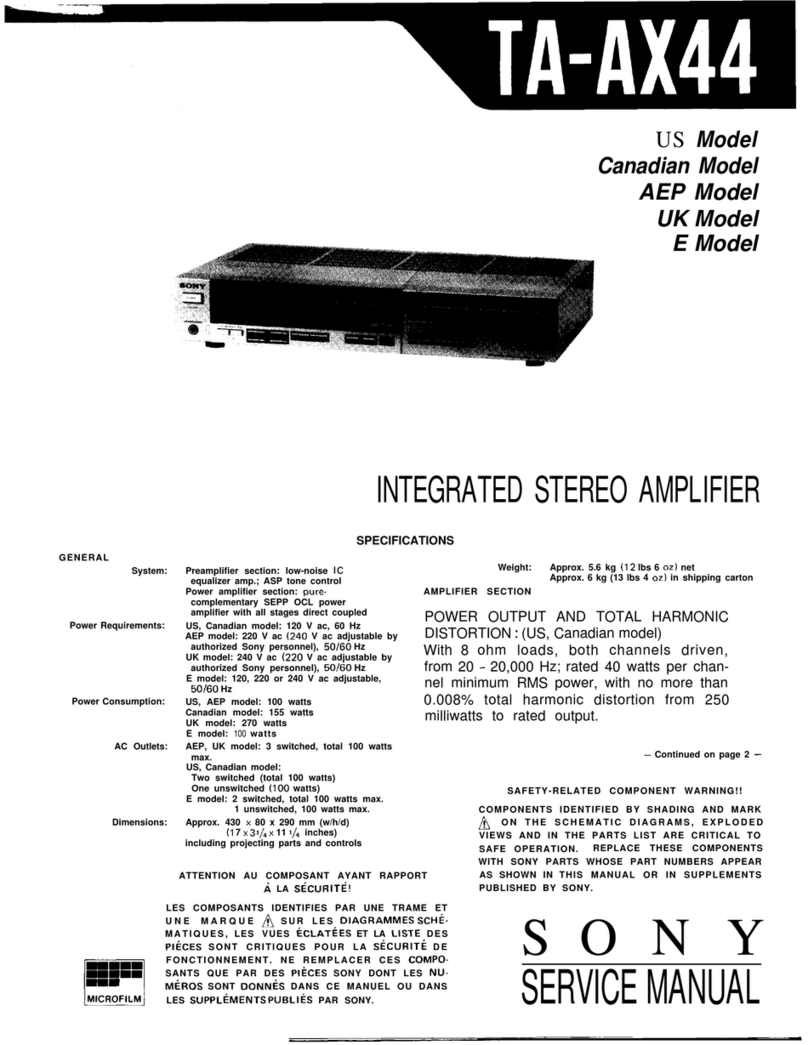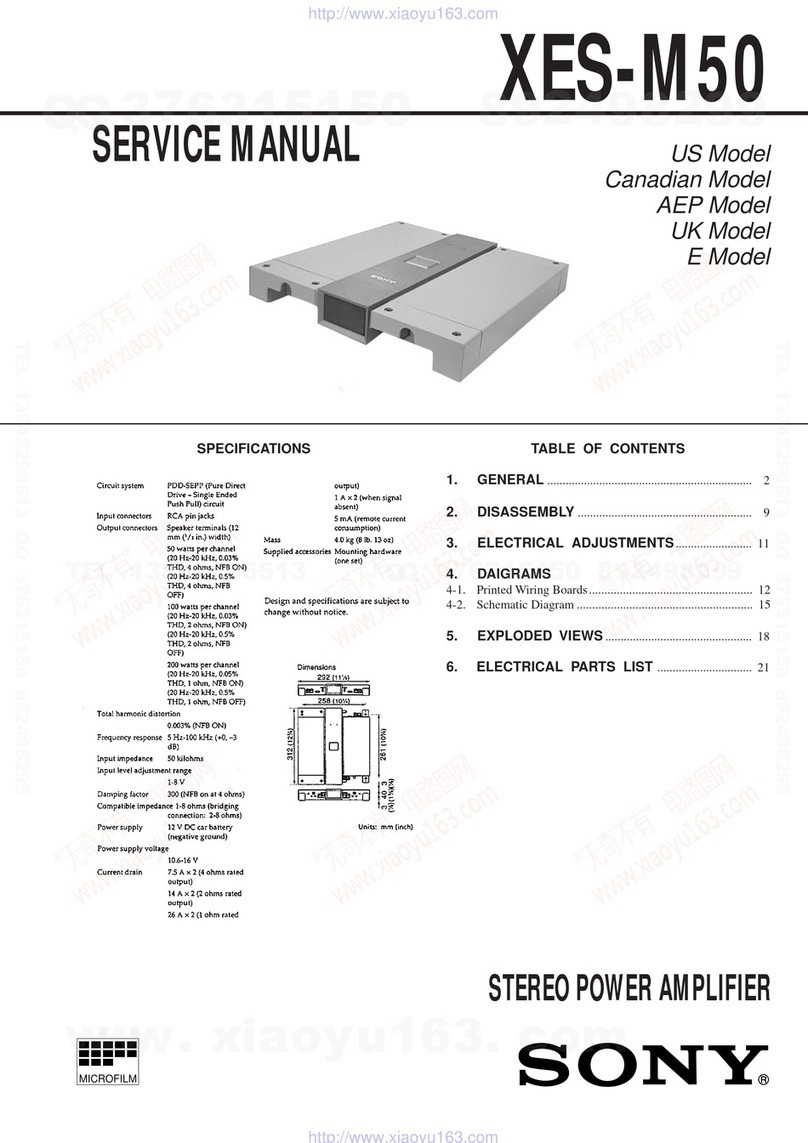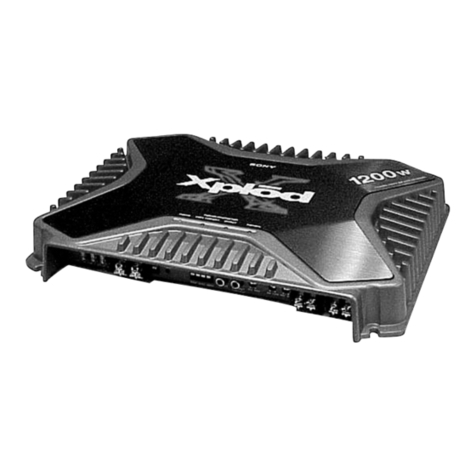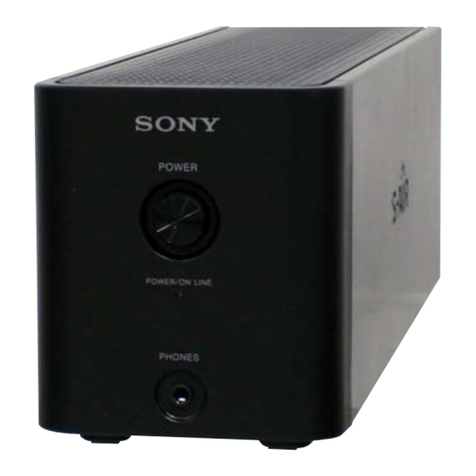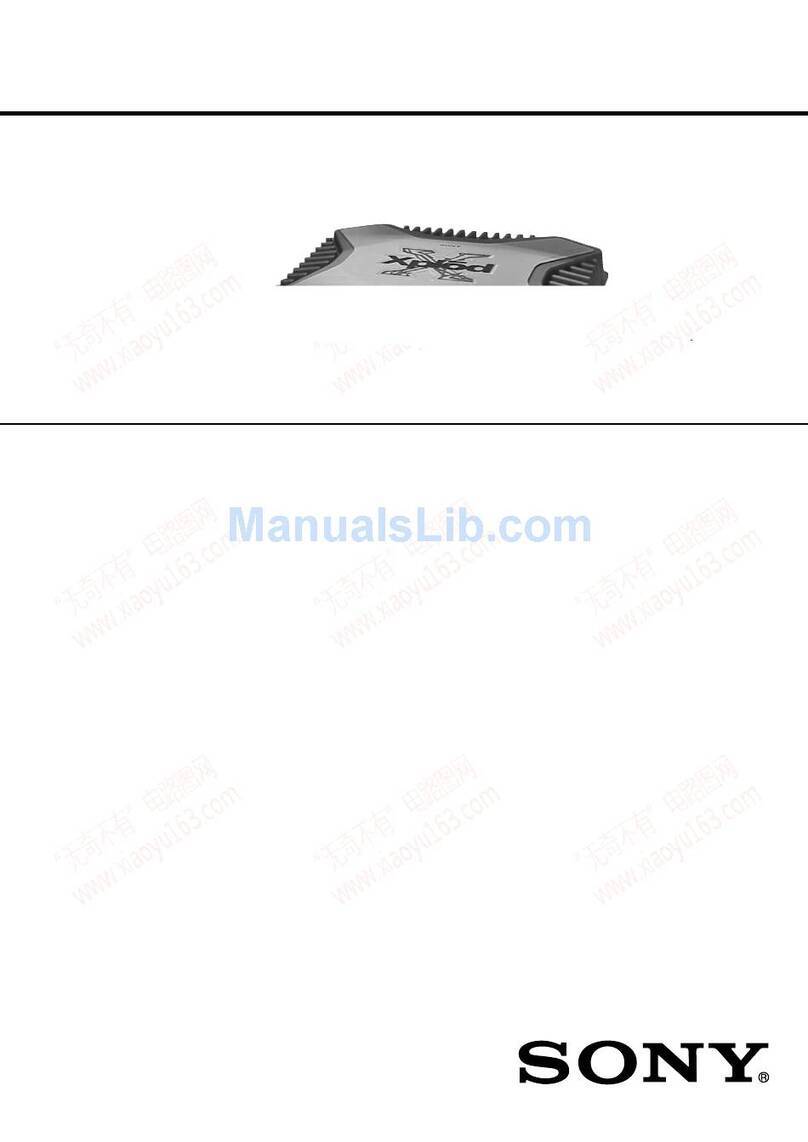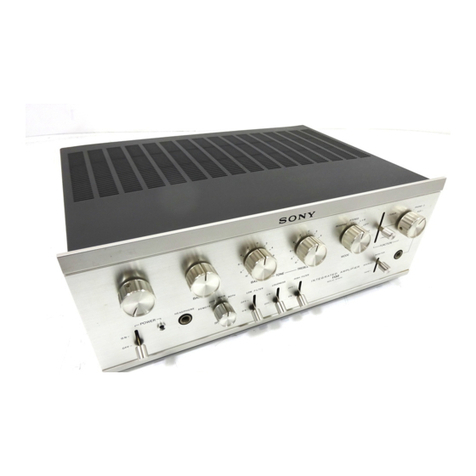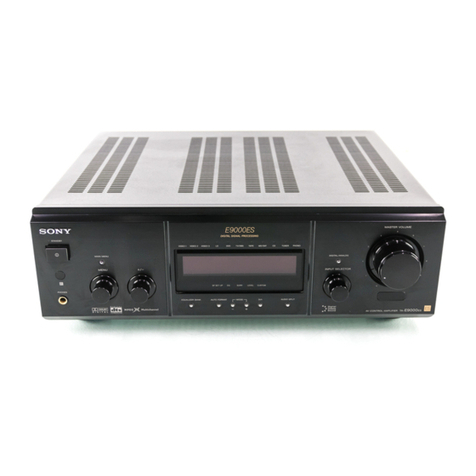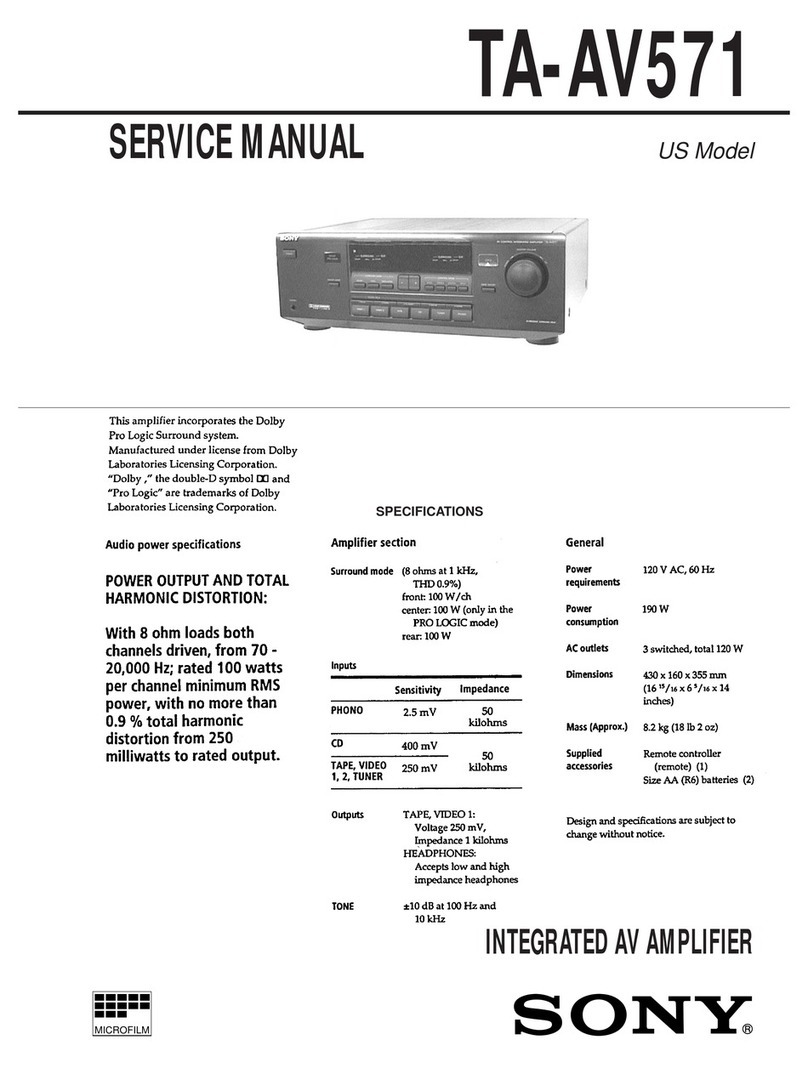XM-N502
3
Ȑʓ
ø 5 × 15 mm
(× 4)
ʕʔ
ʓ
ȑ
ʕ
ʕ
q
Ȓ
ȓPower Connection Wires (not supplied)
Cables de conexión de alimentación (no suministrados)
Cabos de ligação à corrente (não fornecidos)
to a metal point of the car
a un punto metálico del
automóvil
a um ponto metálico do
automóvel
Fuse (25 A)
Fusible (25 A)
Fusível (25 A) +12V car battery
Batería de automóvil de +12V
Bateria do automóvel de +12V
Car audio unit
Sistema de audio para
automóvil
Autorrádio
Remote output*1
Salida remota*1(REM OUT)
Saída para telecomando*1
(REM) less than 450 mm
menos de 450 mm
inferior a 450 mm
*2
*1
If you have the factory original or some other car audio unit without a remote output for the amplifier, connect the
remote input terminal (REMOTE) to the accessory power supply.
In High level input connection, car audio unit can also be activated without need for REMOTE connection. However,
this function is not guaranteed for all car audio units.
*
1
Si dispone del sistema de audio para automóvil original de fábrica o de otro sistema sin una salida remota para el
amplificador, conecte el terminal de entrada remota (REMOTE) a la fuente de alimentación auxiliar.
En la conexión de entrada de alto nivel,el sistema de audio para automóvil también puede activarse sin necesidad de
conexión REMOTE.No obstante, esta función no se garantiza en todos los sistemas de audio para automóvil.
*
1
Se tiver o autorrádio original fornecido de fábrica ou outro sistema de som para automóvel sem uma saída para
telecomando no amplificador,ligue o terminal de entrada para telecomando (REMOTE) à fonte de alimentação para
acessórios.
Na ligação da entrada de nível elevado, também pode activar o autorrádio sem precisar da ligação para telecomando
(REMOTE). No entanto, não é possível garantir o funcionamento desta função em todos os autorrádios.
ȔLine Input Connection (with Speaker Connection ș, Țor Ȝ)
Conexión de entrada de línea (con conexión de altavoces ș, Țu Ȝ)
Ligação de entrada de linha (com ligação às colunas ș, Țou Ȝ)
LINE OUT
Car audio unit
Sistema de audio para
automóvil
Autorrádio
ȕLine Input Connection (with Speaker Connection ț)
Conexión de entrada de línea (con conexión de altavoces ț)
Ligação de entrada de linha (com ligação às colunas ț)
Right channel
Canal derecho
Canal direito
Left channel
Canal izquierdo
Canal esquerdo
LINE OUT
L (BTL) L (BTL)
Car audio unit
Sistema de audio para
automóvil
Autorrádio
ȚSubwoofer (with Input Connection Ȕor Ș)
Altavoz potenciador de graves (con conexión de entrada Ȕó Ș)
Subwoofer (com ligação às entradas Ȕou Ș)
Note
If you wish to use a subwoofer as the monaural
speaker, connect the speaker as illustrated above.
The output signals to the subwoofer will be the
combination of both right and left output signals.
Nota
Si desea utilizar el altavoz potenciador de graves
como altavoz monoaural, conecte el altavoz tal como
se muestra en la ilustración anterior. Las señales de
salida enviadas al altavoz potenciador de graves
serán una combinación de las señales de salida
derecha e izquierda.
Subwoofer (min. 4 Ω)
Altavoz potenciador de graves
(mín. 4 )
Subwoofer (mín. 4 )
Nota
Se quiser utilizar um subwoofer como coluna mono,
ligue a coluna como se mostra acima. Os sinais de
saída para o subwoofer são uma combinação dos
sinais de saída da direita e da esquerda.
ț1-Speaker System (with Input Connection ȕor ȗ)
Sistema de 1 altavoz (con conexión de entrada ȕó ȗ)
Sistema de 1 coluna (com ligação às entradas ȕou ȗ)
Note
Make sure that the line output from the car audio unit
is connected to the jack marked“L (BTL)” on the unit.
Nota
Asegúrese de que la salida de línea del sistema de
audio para automóvil está conectada a la toma con la
marca “L (BTL)”de la unidad.
Right speaker
(min. 4 Ω)
Altavoz derecho
(mín. 4 )
Coluna direita
(mín. 4 )
Left speaker
(min. 4 Ω)
Altavoz izquierdo
(mín. 4 )
Coluna esquerda
(mín. 4 )
Nota
Verifique se a saída de linha do autorrádio está ligada
à tomada com a indicação “L (BTL)” do aparelho.
ȜDual Mode System (with a Bridged Subwoofer Ȕor Ȗ)
Sistema de modo dual (con altavoz potenciador de graves en puente Ȕó
Ȗ)
Sistema de modo duplo (com um subwoofer de ligação em ponte a
Ȕou Ȗ)
C1 C2
L
Subwoofer
Altavoz potenciador de graves
Subwoofer
Left speaker
Altavoz izquierdo
Coluna esquerda
Right speaker
Altavoz derecho
Coluna direita
For details on the values of C1, C2, L, refer to
“Table of crossover values for 6 dB/octave”.
Para obtener más información sobre los valores
de C1, C2 y L, consulte la “Tabla de valores de
cruce para 6 dB/octava”.
Para mais informações sobre os valores de C1,
C2, L, consulte a “Tabela de valores de
cruzamento para 6 dB/oitava”.
ȖHigh Level Input Connection (with Speaker Connection șor Ȝ)
Conexión de entrada de alto nivel (con conexión de altavoces șó Ȝ)
Ligação de entrada de nível elevado (com ligação às colunas șou Ȝ)
Left speaker output
Salida del altavoz izquierdo
Saída da coluna esquerda
Right speaker output
Salida del altavoz derecho
Saída da coluna direita
Striped
Con rayas
Às riscas
Striped
Con rayas
Às riscas
Car audio unit
Sistema de audio para
automóvil
Autorrádio
White
Blanco
Branco
Gray
Gris
Cinzento
Gray
Gris
Cinzento ʔ
R
White
Blanco
Branco L
White/Black striped
Con rayas blancas o
negras
Às riscas brancas/
pretas
Gray/Black striped
Con rayas grises o
negras
Às riscas cinzentas/
pretas
ȗHigh Level Input Connection (with Speaker Connection ț)
Conexión de entrada de alto nivel (con conexión de altavoces ț)
Ligação de entrada de nível elevado (com ligação às colunas ț)
Left speaker output
Salida del altavoz izquierdo
Saída da coluna esquerda
Right speaker output
Salida del altavoz derecho
Saída da coluna direita
Striped
Con rayas
Às riscas
Striped
Con rayas
Às riscas
ʔʔ
Striped
Con rayas
Às riscas
Striped
Con rayas
Às riscas
Car audio unit
Sistema de audio para
automóvil
Autorrádio
ȘHigh Level Input Connection (with Speaker Connection Ț)
Conexión de entrada de alto nivel (con conexión de altavoces Ț)
Ligação de entrada de nível elevado (com ligação às colunas Ț)
Right speaker
Altavoz derecho
Coluna direita
Left speaker
Altavoz izquierdo
Coluna esquerda
White
Blanco
Branco
Gray
Gris
Cinzento
ʔ
Striped
Con rayas
Às riscas
Striped
Con rayas
Às riscas
Car audio unit
Sistema de audio para
automóvil
Autorrádio
ș2-Speaker System (with Input Connection Ȕor Ȗ)
Sistema de 2 altavoces (con conexión de entrada Ȕó Ȗ)
Sistema de 2 colunas (com ligação às entradas Ȕou Ȗ)
Left speaker (min. 2 Ω)
Altavoz izquierdo (mín. 2 )
Coluna esquerda (mín. 2 )
Right speaker (min. 2 Ω)
Altavoz derecho (mín. 2 )
Coluna direita (mín. 2 )
English
Connections
Cautions
ˎ Before making any connections, disconnect the
ground terminal of the car battery to avoid short
circuits.
ˎ Be sure to use speakers with an adequate
power rating. If you use small capacity speakers,
they may be damaged.
ˎ This is a Phase-Inverted Amplifier.
ˎ Do not connect the ¾terminal of the speaker
system to the car chassis, and do not connect
the ¾terminal of the right speaker with that of
the left speaker.
ˎ Install the input and output cords away from the
power supply wire as running them close
together can generate some interference noise.
ˎ This unit is a high powered amplifier.Therefore,
it may not perform to its full potential if used
with the speaker cords supplied with the car.
ˎ If your car is equipped with a computer system
for navigation or some other purpose, do not
remove the ground wire from the car battery. If
you disconnect the wire, the computer memory
may be erased. To avoid short circuits when
making connections, disconnect the +12V power
supply wire until all the other wires have been
connected.
Parts for Installation and
Connections (Ȑ)
Installation
Before Installation
ˎ Mount the unit either inside the trunk or under a
seat.
ˎ Choose the mounting location carefully so the
unit will not interfere with the normal
movements of the driver and it will not be
exposed to direct sunlight or hot air from the
heater.
ˎ Do not install the unit under the floor carpet,
where the heat dissipation from the unit will be
considerably impaired.
Mount the unit (ȑ).
First, place the unit where you plan to install it,
and mark the positions of the 4 screw holes on
the mounting board (not supplied). Then drill a
3mm pilot hole at each mark and mount the unit
onto the board with the supplied mounting
screws. The mounting screws are all 15 mm long,
so make sure that the mounting board is thicker
than 15 mm.
Power connections
Make the terminal connections
(Ȓ).
Pass the wires through the cap, connect the wires,
then cover the terminals with the cap.
Note
When you tighten the screw,be careful not to apply
too much torque* as doing so may damage the
screw.
* 6JGVQTSWGXCNWGUJQWNFDGNGUUVJCP0ŞO
Make the power connections
(ȓ)
Notes on the power supply
ˎ Connect the +12V power supply wire only after all
the other wires have been connected.
ˎ Be sure to connect the ground wire of the unit
securely to a metal point of the car. A loose
connection may cause a malfunction of the
amplifier.
ˎ Be sure to connect the remote control wire of the
car audio unit to the remote terminal.
ˎ When using a car audio unit without a remote
output on the amplifier, connect the remote input
terminal (REMOTE) to the accessory power supply.
ˎ Use a power supply wire with a fuse attached
(25A).
ˎ All power wires connected to the positive battery
post should be fused within 450 mm of the battery
post, and before they pass through any metal.
ˎ Make sure that the vehicle’s battery wires
connected to the vehicle (ground to chassis)*2are
of a wire gauge at least equal to that of the main
power wire connected from the battery to the
amplifier.
ˎ During full-power operation, a current of more than
25 A will run through the system. Therefore, make
sure that the wires to be connected to the +12V and
GND terminals of this unit are at least 14-Gauge
(AWG-14) or have a sectional area of more than
2mm2.
Input Connections
For details on input connections, see Ȕ, ȕ, Ȗ,
ȗand Ș.
Speaker Connections
Turn on or off the LPF switch at the unit rear.
For details on speaker connections,see ș, Ț, ț
and Ȝ.
Table of crossover values for 6 dB/
octave (4 Ω) (Speaker Connections Ȝ)
Crossover
Frequency
unit: Hz
L
(coil)*
unit: mH
C1/C2
(capacitor)*
unit: µF
50 12.7 800
80 8.2 500
100 6.2 400
130 4.7 300
150 4.2 270
200 3.3 200
260 2.4 150
400 1.6 100
600 1.0 68
800 0.8 50
1,000 0.6 39
* Not supplied
Notes
ˎ When using passive crossover networks in a
multi-speaker system, care must be taken as the
speaker system’s impedance should not be lower
than that of the suitable impedance for this unit.
ˎ When you are installing a 12 decibels/octave
system in your car,the following points must be
considered. In a 12 decibels/octave system where
both a choke and capacitor are used in series to
form a circuit, great care must be taken when they
are connected. In such a circuit, there is going to be
an increase in the current which bypasses the
speaker with frequencies around the crossover
frequency.If audio signals continue to be fed into
the crossover frequency area,it may cause the
amplifier to become abnormally hot or the fuse to
blow. Also if the speaker is disconnected, a
series-resonant circuit will be formed by the choke
and the capacitor.In this case, the impedance in the
resonance area will decrease dramatically resulting
in a short circuit situation causing damage to the
amplifier. Therefore, make sure that a speaker is
connected to such a circuit at all times.
Español
Conexiones
Precaución
ˎ Antes de realizar las conexiones, desconecte el
terminal de toma a tierra de la batería del
automóvil para evitar cortocircuitos.
ˎ Asegúrese de utilizar altavoces con una
potencia nominal adecuada. Si emplea
altavoces de capacidad reducida, pueden
dañarse.
ˎ Este amplificador es de fase invertida.
ˎ No conecte el terminal ¾del sistema de
altavoces al chasis del automóvil, ni el terminal
¾del altavoz derecho al del altavoz izquierdo.
ˎ Instale los cables de entrada y salida alejados
del cable de la fuente de alimentación, ya que
en caso contrario puede generarse ruido por
interferencias.
ˎ Esta unidad es un amplificador de alta potencia.
Por tanto, puede no funcionar a pleno
rendimiento si se utiliza con los cables de
altavoz suministrados con el automóvil.
ˎ Si el automóvil está equipado con un sistema de
ordenador para la navegación o para otra
finalidad, no desconecte el conductor de toma a
tierra de la batería del automóvil. Si lo
desconecta, la memoria del ordenador puede
borrarse. Para evitar cortocircuitos al realizar las
conexiones, desconecte el cable de la fuente de
alimentación de +12V hasta conectar todos los
cables.
Componentes de instalación y
conexiones (Ȑ)
Instalación
Antes de realizar la instalación
ˎ Monte la unidad en el interior del maletero o
debajo de un asiento.
ˎ Elija cuidadosamente el lugar de instalación de
forma que la unidad no dificulte las maniobras
normales del conductor y no quede expuesta a
la luz solar directa ni al aire caliente de la
calefacción.
ˎ No instale la unidad debajo de la moqueta del
suelo, en cuyo caso la disipación de calor de la
misma disminuirá considerablemente.
Monte la unidad (ȑ).
En primer lugar, coloque la unidad donde tenga
previsto instalarla y marque sobre la superficie
del tablero de montaje (no suministrado) las
posiciones de los 4 orificios para los tornillos. A
continuación, perfore los orificios con un diámetro
de aproximadamente 3 mm y monte la unidad
sobre el tablero con los tornillos de montaje
suministrados. Ya que la longitud de estos
tornillos es de 15 mm, compruebe que el grosor
del tablero de montaje sea superior a 15 mm.
Conexiones de alimentación
Realice las conexiones de
terminal (Ȓ).
Pase los cables a través de la cubierta,conéctelos
y cubra los terminales con dicha cubierta.
Nota
Al apretar el tornillo, tenga cuidado de no aplicar
demasiada fuerza de torsión*, ya que puede dañarlo.
* El valor de fuerza de torsión debe ser inferior a
a0ŞO
Realice las conexiones de
alimentación (ȓ).
Notas sobre la fuente de alimentación
ˎ Conecte el cable de la fuente de alimentación de
+12V sólo después de haber conectado los otros
cables.
ˎ Asegúrese de conectar firmemente el cable de
toma a tierra de la unidad a un punto metálico del
automóvil. Una conexión floja puede causar fallos
de funcionamiento del amplificador.
ˎ Compruebe que conecta el cable de control remoto
del sistema de audio para automóvil al terminal
remoto.
ˎ Si utiliza un sistema de audio para automóvil sin
salida remota en el amplificador, conecte el
terminal de entrada remota (REMOTE) a la fuente
de alimentación auxiliar.
ˎ Emplee el cable de la fuente de alimentación con
un fusible fijado (25 A).
ˎ Todos los cables de alimentación conectados al
polo positivo de la batería deben conectarse a un
fusible situado a menos de 450 mm del polo de la
batería, y antes de pasar por ninguna pieza
metálica.
ˎ Asegúrese de que los cables de la batería del
vehículo conectados al mismo (a la masa del
chasis)*2tienen una anchura igual o superior a la
del cable de alimentación principal que conecta la
batería con el amplificador.
ˎ Durante el funcionamiento a pleno rendimiento,
fluye por el sistema una corriente superior a 25 A.
Por tanto, compruebe que los cables que va a
conectar a los terminales de +12V y GND de esta
unidad son del calibre 14 (AWG 14) como mínimo o
presentan un área de sección superior a 2 mm2.
Conexiones de entrada
Para obtener más información sobre las
conexiones de entrada, consulte Ȕ, ȕ, Ȗ, ȗy
Ș.
Conexiones de los altavoces
Encienda o apague el interruptor LPF situado en
la parte posterior de la unidad.
Para obtener más información sobre las
conexiones de los altavoces, consulte ș, Ț, țy
Ȝ.
Tabla de valores de cruce para 6 dB/
octava (4 Ω) (Conexión de los altavoces
Ȝ)
Frecuencia de
cruce
unidad: Hz
L
(bobina)*
unidad: mH
C1/C2
(condensador)*
unidad: µF
50 12,7 800
80 8,2 500
100 6,2 400
130 4,7 300
150 4,2 270
200 3,3 200
260 2,4 150
400 1,6 100
600 1,0 68
800 0,8 50
1.000 0,6 39
* No suministrados
Notas
ˎ Al utilizar redes de cruce pasivas en un sistema con
múltiples altavoces, es necesario asegurar que la
impedancia del sistema de altavoces no sea inferior
al valor de impedancia adecuado para esta unidad.
ˎ Al instalar un sistema de 12 decibelios/octava en un
automóvil, hay que tener en cuenta los siguientes
puntos. En un sistema de 12 decibelios/octava
donde se emplea una bobina de choque y un
condensador en serie para formar un circuito, hay
que tener mucho cuidado al conectarlos. En los
circuitos de este tipo, se produce un aumento de la
corriente que pasa por alto el altavoz con
frecuencias próximas a la frecuencia de cruce. Si las
señales de audio siguen enviándose a la zona de
frecuencia de cruce, puede producirse un
sobrecalentamiento anormal del amplificador o
puede fundirse el fusible. Además, si se desconecta
el altavoz, se formará un circuito de resonancia en
serie compuesto por la bobina y el condensador. En
este caso, la impedancia del área de resonancia
disminuirá considerablemente, dando lugar a una
situación de cortocircuito y dañando el altavoz.Por
tanto, es necesario asegurar que haya un altavoz
conectado a un circuito en todo momento.
Português
Ligações
Cuidados
ˎ Antes de fazer qualquer ligação, desligue o
terminal de massa da bateria do automóvel
para evitar curtos-circuitos.
ˎ Verifique se as colunas utilizadas têm uma
potência nominal adequada. Se utilizar colunas
de baixa capacidade, pode danificá-las.
ˎ Este amplificador é um amplificador de fase
invertida.
ˎ Não ligue o terminal ¾do sistema de colunas
ao chassis do automóvel nem o terminal ¾da
coluna direita ao terminal da coluna esquerda.
ˎ Instale os cabos de entrada e de saída longe do
cabo de alimentação porque se estiverem muito
perto podem gerar interferências.
ˎ Este aparelho é um amplificador de grande
potência. Como tal, pode não conseguir
utilizá-lo com a potência máxima se usar os
cabos para colunas fornecidos com o
automóvel.
ˎ Se o automóvel estiver equipado com um
computador de bordo para navegação ou para
outra finalidade, não retire o fio de ligação à
massa da bateria do automóvel. Se desligar o
fio, apaga a memória do computador. Para
evitar curtos-circuitos quando fizer as ligações,
ligue o cabo de ligação à corrente de +12V
somente depois de ligar todos os outros cabos.
Peças para instalação e ligações
(Ȑ)
Instalação
Antes de fazer a instalação
ˎ Monte o aparelho dentro da mala ou por baixo
do banco.
ˎ Escolha cuidadosamente o local de montagem
de modo a que o aparelho não interfira com os
movimentos normais do condutor e não fique
exposto à incidência direta dos raios solares
nem ao ar quente proveniente do sistema de
aquecimento.
ˎ Não instale o aparelho por baixo do tapete do
carro porque impedirá a dissipação de calor do
aparelho.
Monte o aparelho (ȑ).
Em primeiro lugar, coloque o aparelho no local
onde o pretende instalar e marque as posições
dos 4 furos para os parafusos na placa de
montagem (não fornecida). Depois,faça um furo
de 3 mm em cada marca e monte o aparelho na
placa, utilizando os parafusos de montagem
fornecidos. Como os parafusos de montagem têm
15 mm de comprimento, deve verificar se a placa
de montagem tem uma espessura superior a
15mm.
Ligações elétricas
Ligue os terminais (Ȓ).
Passe os fios pela capa de proteção, ligue-os e
depois tape os terminais com a capa de proteção.
Nota
Aperte bem o parafuso, mas não com binário
excessivo* para evitar danificá-lo.
* O valor do binário aplicado deve ser inferior a
a0ŞO
Estabelecer as ligações elétricas
(ȓ)
Notas sobre o fornecimento de corrente
ˎ Ligue o cabo de ligação à corrente de +12V somente
depois de ter ligado todos os outros cabos.
ˎ Ligue o fio de massa do aparelho a um ponto
metálico do automóvel. Uma ligação mal feita
pode avariar o amplificador.
ˎ Verifique se ligou o cabo do telecomando do
autorrádio ao terminal para telecomando.
ˎ Quando utilizar um autorrádio sem saída para
telecomando no amplificador,ligue o terminal de
entrada para telecomando (REMOTE) à fonte de
alimentação para acessórios.
ˎ Utilize um cabo de ligação à corrente com um
fusível incorporado (25 A).
ˎ Todos os cabos elétricos ligados ao borne positivo
da bateria devem ter um fusível a uma distância de
450 mm do borne da bateria e antes de passarem
por qualquer parte metálica.
ˎ Verifique se os cabos da bateria ligados ao
automóvel (ligação de massa ao chassis)*2têm uma
medida pelo menos igual à do cabo principal que
liga a bateria ao amplificador.
ˎ Durante o funcionamento com potência total, o
sistema é percorrido por uma corrente superior a
25A. Assim, verifique se os cabos que vai ligar aos
terminais +12V e GND deste aparelho têm um
calibre superior a 14 (AWG-14) ou uma secção
transversal superior a 2 mm2.
Ligações de entrada
Para obter mais informações acerca das ligações
de entrada, consulte Ȕ, ȕ, Ȗ, ȗe Ș.
Ligações às colunas
Ligue ou desligue o interruptor LPF da parte
de trás do autorrádio.
Para obter mais informações acerca das ligações
das colunas, consulte ș, Ț, țe Ȝ.
Tabela de valores de cruzamento para
6 dB/oitava (4 )
(Ligações às colunas Ȝ)
Frequência de
cruzamento
Unidade: Hz
L (bobina)*
Unidade: mH
C1/C2
(condensador)*
Unidade: F
50 12,7 800
80 8,2 500
100 6,2 400
130 4,7 300
150 4,2 270
200 3,3 200
260 2,4 150
400 1,6 100
600 1,0 68
800 0,8 50
1.000 0,6 39
* Não fornecido
Notas
ˎ Se utilizar redes de cruzamento passivas num
sistema com várias colunas, é preciso assegurar-se
de que a impedância do sistema de colunas não é
inferior ao valor de impedância adequado para este
aparelho.
ˎ Se instalar um sistema de 12 decibéis/oitava no
automóvel, é preciso ter em atenção os seguintes
pontos. Num sistema de 12 decibéis/oitava em que
se utiliza uma bobina de choque e um condensador
em série para formar um circuito,é preciso ter
muito cuidado ao ligá-los. Neste circuito, vai haver
um aumento na corrente que passa na coluna,
atingindo frequências muito próximas da
frequência de cruzamento. Se continuarem a ser
enviados sinais de áudio para a zona de frequência
de cruzamento, o amplificador pode sobreaquecer
ou pode rebentar um fusível. Além disso, se
desligar a coluna, forma-se um circuito de
ressonância em série composto pela bobina de
choque e pelo condensador.Neste caso, a
impedância na zona de ressonância diminui
drasticamente, dando lugar a uma situação de
curto-circuito e danificando o amplificador. Assim,
tem de haver sempre uma coluna ligada a este
circuito.
SECTION 2
GENERAL
This section is extracted
from instruction manual.
ʓ
ȑ
Installation
Before Installation
ˎ Mount the unit either inside the trunk or under a
seat.
ˎ Choose the mounting location carefully so the
unit will not interfere with the normal
movements of the driver and it will not be
exposed to direct sunlight or hot air from the
heater.
ˎ Do not install the unit under the floor carpet,
where the heat dissipation from the unit will be
considerably impaired.
Mount the unit (ȑ).
First, place the unit where you plan to install it,
and mark the positions of the 4 screw holes on
the mounting board (not supplied). Then drill a
3mm pilot hole at each mark and mount the unit
onto the board with the supplied mounting
screws. The mounting screws are all 15 mm long,
so make sure that the mounting board is thicker
than 15 mm.
Power connections
Make the terminal connections
(Ȓ).
Pass the wires through the cap, connect the wires,
then cover the terminals with the cap.
Note
When you tighten the screw,be careful not to apply
too much torque* as doing so may damage the
screw.
* 6JGVQTSWGXCNWGUJQWNFDGNGUUVJCP0ŞO
Make the power connections
(ȓ)
Notes on the power supply
ˎ Connect the +12V power supply wire only after all
the other wires have been connected.
ˎ Be sure to connect the ground wire of the unit
securely to a metal point of the car. A loose
connection may cause a malfunction of the
amplifier.
ˎ Be sure to connect the remote control wire of the
car audio unit to the remote terminal.
Instalación
Antes de realizar la instalación
ˎ Monte la unidad en el interior del maletero o
debajo de un asiento.
ˎ Elija cuidadosamente el lugar de instalación de
forma que la unidad no dificulte las maniobras
normales del conductor y no quede expuesta a
la luz solar directa ni al aire caliente de la
calefacción.
ˎ No instale la unidad debajo de la moqueta del
suelo, en cuyo caso la disipación de calor de la
misma disminuirá considerablemente.
Monte la unidad (ȑ).
En primer lugar, coloque la unidad donde tenga
previsto instalarla y marque sobre la superficie
del tablero de montaje (no suministrado) las
posiciones de los 4 orificios para los tornillos. A
continuación, perfore los orificios con un diámetro
de aproximadamente 3 mm y monte la unidad
sobre el tablero con los tornillos de montaje
suministrados. Ya que la longitud de estos
tornillos es de 15 mm, compruebe que el grosor
del tablero de montaje sea superior a 15 mm.
Conexiones de alimentación
Realice las conexiones de
terminal (Ȓ).
Pase los cables a través de la cubierta,conéctelos
y cubra los terminales con dicha cubierta.
Nota
Al apretar el tornillo, tenga cuidado de no aplicar
demasiada fuerza de torsión*, ya que puede dañarlo.
* El valor de fuerza de torsión debe ser inferior a
a0ŞO
Realice las conexiones de
alimentación (ȓ).
Notas sobre la fuente de alimentación
ˎ Conecte el cable de la fuente de alimentación de
+12V sólo después de haber conectado los otros
cables.
Instalação
Antes de fazer a instalação
ˎ Monte o aparelho dentro da mala ou por baixo
do banco.
ˎ Escolha cuidadosamente o local de montagem
de modo a que o aparelho não interfira com os
movimentos normais do condutor e não fique
exposto à incidência direta dos raios solares
nem ao ar quente proveniente do sistema de
aquecimento.
ˎ Não instale o aparelho por baixo do tapete do
carro porque impedirá a dissipação de calor do
aparelho.
Monte o aparelho (ȑ).
Em primeiro lugar, coloque o aparelho no local
onde o pretende instalar e marque as posições
dos 4 furos para os parafusos na placa de
montagem (não fornecida). Depois,faça um furo
de 3 mm em cada marca e monte o aparelho na
placa, utilizando os parafusos de montagem
fornecidos. Como os parafusos de montagem têm
15 mm de comprimento, deve verificar se a placa
de montagem tem uma espessura superior a
15mm.
Ligações elétricas
Ligue os terminais (Ȓ).
Passe os fios pela capa de proteção, ligue-os e
depois tape os terminais com a capa de proteção.
Nota
Aperte bem o parafuso, mas não com binário
excessivo* para evitar danificá-lo.
* O valor do binário aplicado deve ser inferior a
a0ŞO
Estabelecer as ligações elétricas
(ȓ)
Notas sobre o fornecimento de corrente
ˎ Ligue o cabo de ligação à corrente de +12V somente
depois de ter ligado todos os outros cabos.
ˎ Ligue o fio de massa do aparelho a um ponto
metálico do automóvel. Uma ligação mal feita
pode avariar o amplificador.
(E, Indian)



